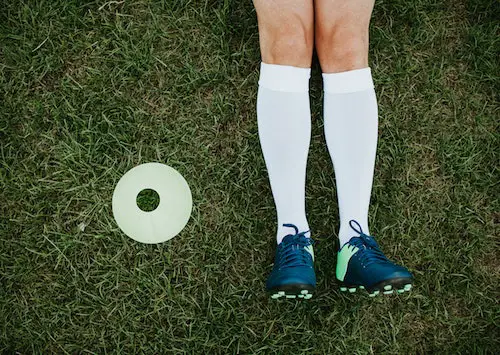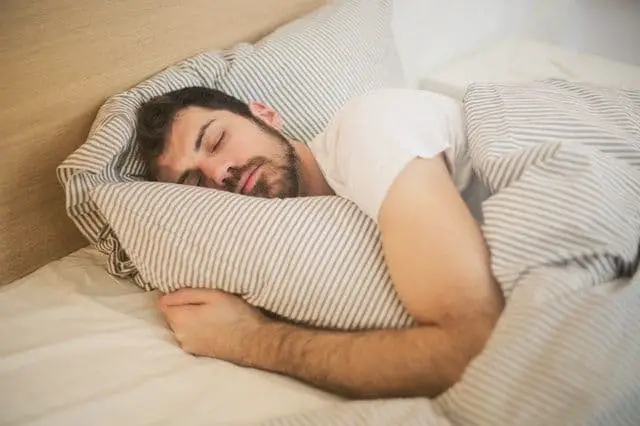You’ve seen them in the bandage section at Wal-Mart or Target before – they’re usually around the same area as the ACE bandages, knee braces, and Band Aids, but you may have never paid much attention to the rack of compression socks simply because you never needed them.
Can you sleep in compression socks, and should you? While you can sleep in compression socks, it does not necessarily mean that you should do it. In fact, you should only sleep in them if it is directly recommended by your doctor.
This is due to the fact that compression socks are meant to work while you are standing up and your blood is flowing vertically. When you are laying down, this process is not the same and can be risky.

Compression socks are knee or thigh high socks that hug the leg tight. They enhance and improve blood circulation, ease pain in your legs, and they have many benefits.
The technology behind the socks are pretty simple, but ingenious – the pressure, the main feature of the sock, starts at the ankle and gradually loosens up towards the knee which promotes a consistent flow of blood upward back to your heart. However, there is speculation around whether or not they should be slept in.
Can You Sleep in Compression Socks?

The short answer to the question of whether or not you can sleep in compression socks is yes. However, it is only necessary if prescribed by your doctor.
The science behind the socks promotes continued blood circulation better when your body is in a vertical or sitting position most of the time.
When you are laying down flat in bed, your body is leveled, so blood flows better. However, even still, if your issues are severe enough and you have been ordered by a doctor to wear them day and night, follow the expert’s instructions.
Compressions socks are a preventative solution, so if your physician recommends it, do your best to follow the doctor’s orders! There are very few major health downfalls to wearing compression socks when you sleep.
Here are some of the negative effects that come with sleeping in compression socks:
●They become less effective
●Could effect circulation
●Can make a few preexisting conditions worse
First of all, compression socks can become less effective when you wear them during sleep. Most compression socks companies state that compression socks are safe to wear at night, but are rendered more ineffective if the person is healthy and can do without them.
It is also not recommended to wear compression socks to sleep and it is also deemed unsafe because the added pressure to your ankles while your body is laying down for a long period of time can cause your circulation to cut off, which defeats the purpose of the socks entirely.
This article is owned by Sleeping Report and was first published on June 3, 2019
If is insisted that you must wear them at night, then you should wear the lowest level of compression sock that you can to avoid that. Staying away from compression socks at night as long as you don’t need them is always recommended.
As stated before, people who suffer from certain conditions should not wear compression socks due to the fact that the condition they have could possible worsen if worn for too long.
People who suffer from peripheral artery disease, plaque buildup in arteries supplying the brain with blood, may find that they lack more oxygen flowing through their arteries and that their blood flow is impaired.
Those suffering from skin conditions may also find that their condition worsens if that pressure is added to the infected areas, and therefore should not wear compression socks to bed.
The positives of wearing compression socks
As you can see, there are a few negative effects that can come with wearing compression socks at night when you don’t need them. These socks do, however, provide a vital solution to a major health issue that plagues people all over the world.
This article is owned by Sleeping Report and was first published on June 3, 2019
Compression socks are worn after leg surgery or by those who have issues with blood clots, as they not only relieve pain, but also prevent more clots from forming.
Pregnant women, athletes, and people who take long haul flights also find great practical use of compression socks, but they also are great for helping to prevent or help treat spider and varicose veins too!
They come in various compression measurements and each range is optimal for certain needs. The measurements or “ratings” are the amount of pressure being applied to the leg. For instance, the lightest compression is 8-15 mmHg and is great for aches and pains and reducing swelling while the most severe compression is at 40-50 mmHg and is best used for treating Deep Vein Thrombosis and severe lymphoma.
The lighter pressured socks are for healthy people, or those with more mild symptoms and discomfort, while the higher pressured socks are considered “medical grade” and are often prescribed in order to contain serious issues in the leg or to prevent an issue from progressing further.
Despite being very safe and effective, compression socks aren’t made for everybody. People suffering from arterial disease should not wear them because it could lead to ischemic necrosis (the death of bone tissue) and people with skin sensation disorders are not recommended to wear them either.
You can typically find them at any pharmacy or store that sells medication and they can range drastically in price, but if you have insurance, you may be covered if your doctor prescribes them!
Believe it or not, compression socks have quite a long history. The earliest record of compression socks claims to be from the Neolithic period, also known as the New Stone age.
It is believed that compression socks existed around 5000 BC because cave paintings discovered from that era appeared to have soldiers with bandaged legs.
Though historians are unsure whether the bandaged legs were done for the compression or for fashion or tradition, they assume they were worn for the protection of the legs and to optimize the movement and longevity of the soldiers.
In modern world history, compression socks were used to treat pulmonary embolisms back in Germany. Pulmonary embolisms occur when blood clots form anywhere in the body and end up in the lungs, cutting off blood flow and ultimately leading to death.
Fischer and Lasker, two phlebologists of the 1800s discovered that adding pressure to the legs reduced the probability of clots forming there. They were used for many years in Europe before finally reaching the United States in the 1950s.
Compression socks are generally prescribed and/or used to keep the flow of blood throughout the compressed area flowing freely and back to the heart. People who wear compression socks for various reasons, some not seriously related to preexisting health issues but for more of preventative measure.
Here Are Some of the Ways That Compression Socks Are Used.

●Athletes (for flow of oxygen)
●People with varicose veins/other blood-related conditions
●Pregnant women
●Frequent travelers
Athletes often wear compression socks to help the flow of oxygen through their blood and to prevent tissue damage while performing. Though studies show that they do not affect athletic performance, athletes tend to recover faster from fatigue after wearing them.
People with varicose veins or other blood-related issues in their legs, on the other hand, wear them to keep blood from further collecting in their legs and as well as to prevent future blood clotting issues.
Many seniors and people who undergo leg surgery are prescribed compression socks to ease the pain and to lessen the impact of the existing blood problems in their legs.
Pregnant women, in particular, are at a higher risk of getting Deep Vein Thrombosis (DVT) and are more susceptible to blood clots, so compression socks serve as a preventative measure. They also provide comfort and relieve swelling in this scenario.
Compression socks are also great for people who travel on long or extra long haul flights, 6 hours or more, as they prevent blood from clotting while traveling for a long period of time.
They also reduce the swelling that is often inevitable when traveling at high altitudes for long hauls and can provide more comfort and keep your legs warm.
In addition to wearing compression socks on planes, Travel Channel recommends also getting up, walking around, staying hydrated, and even finding ways to move and stretch your legs in your seat if necessary.
Should I Sleep in Compression Socks?

After reading all about compression socks and their uses, along with the effects that can come with sleeping while wearing them, you might be wondering whether or not you should sleep in compression socks.
In this section, we will tie everything up by discussing the factors that you will need to consider while deciding whether or not you should sleep in compression socks.
Here are some of the factors to consider:
•Was this practice recommended by your doctor?
•Do you have any preexisting health conditions?
Unless specifically prescribed by your doctor, it is not recommended or necessary to wear your compression socks while you sleep.
If you are unsure of the severity of your issues, however, you should visit your doctor as soon as possible to discuss the proper usage of your compression socks or to be prescribed or recommended socks that fit your needs.
Final Thoughts
All in all, compression socks can really be a big help to those who really need them, but it is not always necessary to wear them overnight while you sleep. As long as you have the recommendation from your doctor to do so, you will not have any problems with sleeping in compression socks.
SleepingReport.com copyright article was updated on ..
On the other hand, if it is not necessary for you to be using the compression socks while you are sleeping, then you simply shouldn’t in order to get the best results out of the product.

